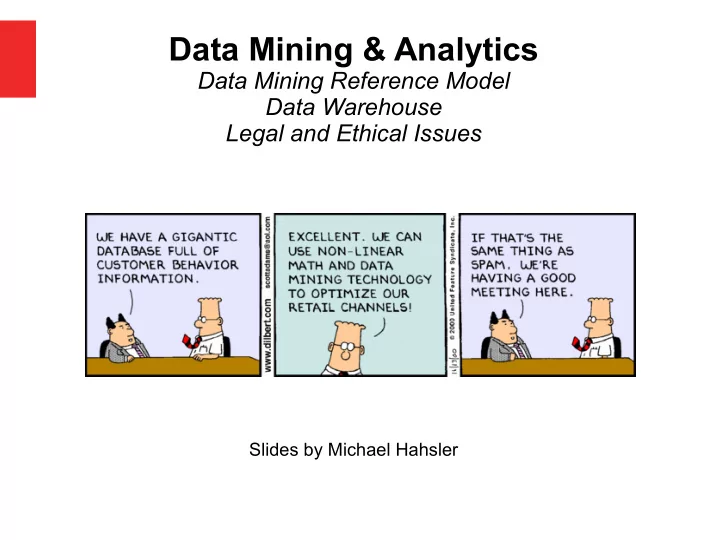

Data Mining & Analytics Data Mining Reference Model Data Warehouse Legal and Ethical Issues Slides by Michael Hahsler
Data Mining & Analytics ● Analytics is the discovery and communication of meaningful patterns in data. ● Analytics relies on the simultaneous application of statistics, computer programming and operations research to quantify performance. ● Analytics often favors data visualization to communicate insight. [Wikipedia]
Analytics and Visualization ● Infoviz is a field by its own. ● Napoleon's Army in Russia by Charles Minard (around 1850)
Do you notice the slight flaw? Do you notice the slight flaw?
Data Mining & Analytics OR Data Mining / Stats Statistics OR Machine Learning DB / CS
CRISP-DM Reference Model C ross I ndustry S tandard ● P rocess for D ata M ining De facto standard for ● conducting data mining and knowledge discovery projects. Defines tasks and outputs. ● Now developed by IBM as the ● Analytics Solutions Unified Method for Data Mining/Predictive Analytics (ASUM-DM). SAS has SEMMA and most ● consulting companies use their own process.
Tasks in the CRISP-DM Model
Problem: Mining Point of Sale (POS) Data
Problem: How is POS data stored? ● Relational data base? ● How do the tables look like? ● Has every store/region its own data base? ● What if I want to know how many units of product A were sold in the last three month in Texas? ● This must be easier!
Data Warehouse
EL T: Extract, Transform and Load ● Extracting data from outside sources ● Transforming it to fit analytical needs. E.g., – Clean (missing data, wrong data) – Translate (1 → "female") – Join (from several sources) – Calculate and aggregate data ● Loading it into the end target (data warehouse)
Data Warehouse ● Subject Oriented: Data warehouses are designed to help you analyze data in a certain area (e.g., sales). ● Integrated: Integrates data from disparate sources into a consistent format. ● Nonvolatile : Data in the data warehouse are never overwritten or deleted. ● Time Variant : they maintain both historical and (nearly) current data.
OLAP: OnLine Analytical Processing Operations: ● Slice Smartphones ● Dice ● Drill-down Product ● Roll-up ● Pivot Time 2012 TX Region For fast operation OLAP requires a special database structure (Snow-flake scheme)
Online Transcation Processing (OL TP) vs. Online Analytical Processing (OLAP) OLTP OLAP users clerk, IT professional knowledge worker function day to day operations decision support DB design application-oriented subject-oriented data current, up-to-date historical, detailed, flat relational summarized, multidimensional isolated integrated, consolidated usage repetitive ad-hoc access read/write lots of scans index/hash on prim. key unit of work short, simple transaction complex query # records accessed tens millions #users thousands hundreds DB size 100MB-GB 100GB-TB query throughput, response metric transaction throughput
Legal, Privacy and Security Issues ?
Legal, Privacy and Security Issues ● Are we allowed to collect the data? ● Are we allowed to use the data? ● Is privacy preserved in the process? ● Is it ethical to use and act on the data? ● Problem: Internet is global but legislation is local!
Legal, Privacy and Security Issues Data-Gathering via Apps Presents a Gray Legal Area By KEVIN J. O’BRIEN Published: October 28, 2012 BERLIN — Angry Birds, the top-selling paid mobile app for the iPhone in the United States and Europe, has been downloaded more than a billion times by devoted game players around the world, who often spend hours slinging squawking fowl at groups of egg-stealing pigs. When Jason Hong, an associate professor at the Human-Computer Interaction Institute at Carnegie Mellon University, surveyed 40 users, all but two were unaware that the game was storing their locations so that they could later be the targets of ads ....
Here is what the small print says... USA Today Network Josh Hafner, USA TODAY 2:38 p.m. EDT July 13, 2016 P okémon Go’s constant location tracking and camera access required for gameplay, paired with its skyrocketing popularity, could provide data like no app before it. “Their privacy policy is vague,” Hong said. “I’d say deliberately vague, because of the lack of clarity on the business model.” ... The agreement says Pokémon Go collects data about its users as a “business asset.” This includes data used to personally identify players such as email addresses and other information pulled from Google and Facebook accounts players use to sign up for the game. If Niantic is ever sold, the agreement states, all that data can go to another company.
Recommend
More recommend